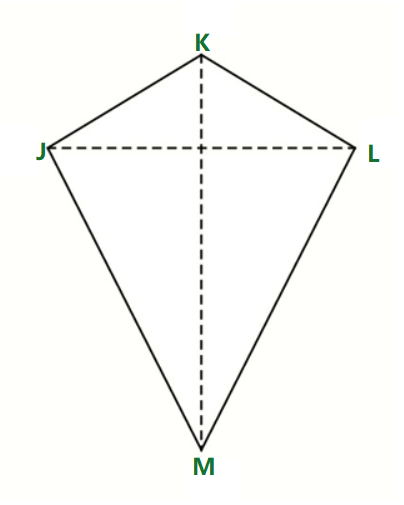
In this case, d1 = 12 inches and d2 = 18 inches, so the area of the kite is 1/2 * 12 * 18 = 108 square inches.
#AREA OF A KITE HOW TO#
To learn how to use the angle of the kite to find the length of. In this article, we will focus on the area of a kite and its formula. The area of the kite equals 20 x 15 x sin150, which equals 300 x sin150, or 150 square inches. The elements of a kite are its 4 angles, its 4 sides, and 2 diagonals. A kite is a quadrilateral in which two pairs of adjacent sides are equal.
#AREA OF A KITE PDF#
To find the area of a kite, we need to use the formula A = 1/2 * d1 * d2, where d1 and d2 are the lengths of the kite’s diagonals. Area of kite is the space enclosed by a kite. Plug in the values of the diagonals in the formula A 1/2 (d 1 d 2) and find the area of the kite, in these 6th grade pdf worksheets, presenting problems as illustrations with integers 20 in level 1 and 10 in level 2. where displaystyle d1 is the length of one diagonal and displaystyle d2 is the length of another diagonal. The area of the kite is 108 square inches. Find The Area Of A Kite : Example Question 3. Find the area of a kite with diagonals of 12 inches and 18 inches.

The area of a kite can found by using the following equation: A = 1/2bh. To find the area of a kite, we need to use the formula A = 1/2 * d1 * d2, where d1 and d2 are the lengths of the kite’s diagonals. Penrose used this rhombus, split into two quadrilaterals, a dart and a kite, to make his famous tiling which fills the plane but, unlike a tessellation, does not repeat itself by translation or rotation. The area of kite ABCD given below is ½ × AC × BD. Here (d)1and (d)2are long and short diagonals of a kite. The area of a kite given by the formula A = 1/2bh, where A is the area, b is the base, and h is the height. The formula to determine the area of a kite is: Area ½ × (d)1× (d)2. In flight, the air moving around the kite’s wings generates lift, forcing the kite to fly.A kite is a tethered heavier-than-air craft with wing surfaces that react against the wind to create lift and drag.Anchors heavy objects, such as bags of sand, that connected to the kite via the tethers. Wings airfoils that shaped to generate lift. A kite consists of wings, tethers, and anchors.A kite is a tethered heavier-than-air craft with wing surfaces that react against the air to create lift and drag.Kites can flown in a variety of wind speeds and can maneuvered to change direction. Every kite is an orthodiagonal quadrilateral, meaning that its two diagonals are at right angles to each other.It also has a high lift-to-drag ratio, which means it requires less power to stay in the air than other aircraft. In other words, the area of a kite can be defined as the amount of space encompassed or enclosed by a kite in a two-dimensional plane.Area Of A Kite Displaying top 8 worksheets found for - Area Of A Kite. KITE is registered as a Section 8 Company, by transforming the erstwhile ITSchool Project, which revolutionised the education system of the State. Area of a kite formula, given two non-congruent side lengths and the angle between those. Use this worksheet to practice finding area of a kite. Area of a kite formula, given kite diagonals. A kite has a stable flight pattern and can stay in the air for long periods of time. This set of area of a kite worksheets for 7th grade and 8th grade students specifies the lengths of the diagonals in varied units.The area of the kite equals 20 x 15 x sin150°, which equals 300 x sin150°, or 150 square inches. Give each group a different-sized outline of a kite and a set of pattern blocks. For this activity, break your students into pairs or small groups.

For instance, say you have a kite with two sides that are 20 and 15 inches long, with an angle of 150° between them. Area of a Kite Activities Use Tiles and Blocks. To do this, use the formula A = a x b x sinC, where a and b are the lengths of the sides and C is the angle between them. Two congruent equilateral triangles with sides of length are connected so that they share a side. If you don’t know the lengths of the diagonals, you can find the area of the kite using the lengths of two non-congruent sides (that is, two sides that are not of the same length) and the size of the angle between them. Which of the following shapes is a kite represents the length of one diagonal and represents the length of the other diagonal. For example, if you have a kite with a diagonal of 7 inches and another diagonal of 10 inches, the area of the kite would equal (7 x 10)/2, or 35 square inches. If you know the lengths of these diagonals, you can plug them into the formula A (area) = xy/2, where x and y are the two diagonals. You can easily find the area of a kite if you know the lengths of the diagonals, or the two lines that connect each of the adjacent vertices (corners) of the kite.


 0 kommentar(er)
0 kommentar(er)
